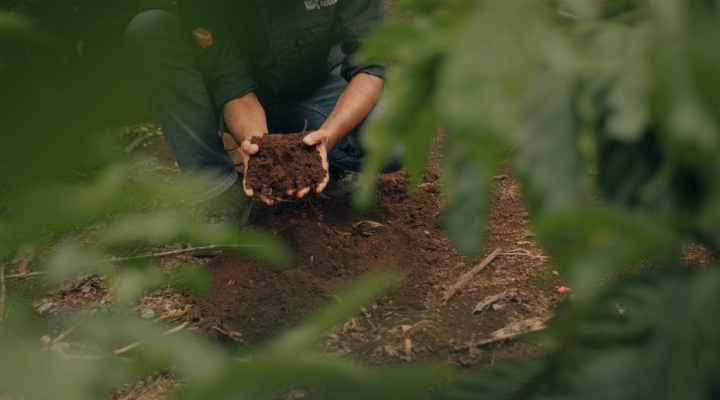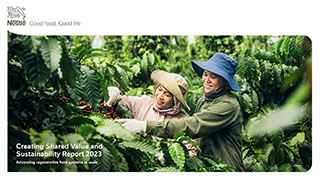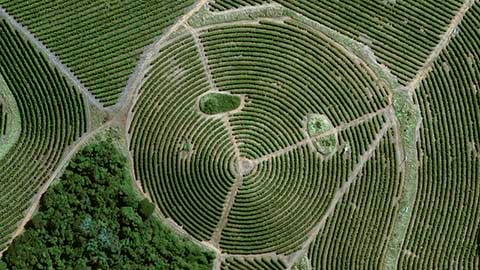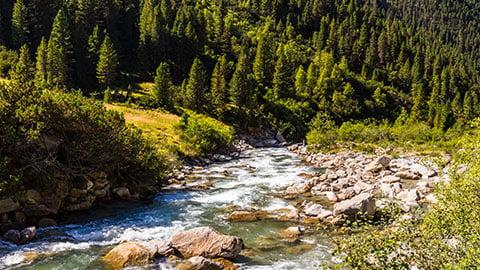Regenerative agriculture

Our Net Zero Roadmap shows that nearly two-thirds of our greenhouse gas emissions come from agriculture, so addressing these is essential for achieving our objectives.
We are supporting farmers and food producers to be part of this transformation by scaling regenerative agriculture, aiming to improve soil health, sequester carbon, support food security, restore water resources and enable biodiversity.
Toward more regenerative practices on farms
What is regenerative agriculture?
Regenerative agriculture is a holistic approach to farming that actively supports the three key agricultural resources – biodiversity, water and soil – and which can benefit communities as part of a just transition.
The Nestlé model brings regenerative agriculture to life through five pillars: biodiversity, water security and quality; soil health; diverse cropping systems and livestock integration; collective and landscape action.
The main pillars of regenerative agriculture
-
Biodiversity, collective & landscape actions We aim to safeguard and increase biodiversity above and below the ground. Plant life can be enhanced with more diversified crops, intercropping or planting cover crops between harvests, while encouraging more abundant microbes, fungi and animal life – including invertebrates, insects and bird life – can contribute to improved soil nutrient cycles, pollination, fertility and productivity.
Ecosystems that exist in this kind of natural equilibrium can also enhance farmers’ livelihoods and improve their resilience to climate change. In the farms and landscapes we source from, Nestlé is supporting farmers by providing shade and fruit trees that provide protection for crops.

-
Water security and quality Protecting the quality of natural waters and improved stewarding of scarce water resources is essential to regeneration. We recognize the need to play our part in helping to protect water sources: at Nestlé Waters, our bottled-water business; throughout our agricultural supply chain and production operations; and in the communities where Nestlé has an impact.
A more strategic approach to irrigation – from sprinkler, to drip and sub-service irrigation – minimizes water evaporation compared to surface irrigation. Digital technology is also helping farms understand when land requires water, which can prevent over-use.
We also aim to reduce chemical farm inputs and optimize organic fertilization and biological pest control to reduce run-off.
-
Soil health To grow the food that we and our pets eat, we need arable land and healthy soil. This vital resource has been degraded by decades of changing land use such as urbanization and deforestation. It has also suffered from the over-application of herbicides and pesticides and the practice of mono-cropping.
We are helping to scale up farming practices that help protect soil health and increase soil organic matter by launching regenerative agriculture initiatives through our Farmer Connect program, which works closely with more than 500 000 farmers and 150 000 suppliers as well as local communities.
Initiatives include crop rotation, mulching, organic fertilizers and minimizing tillage. Organically ‘rich’ soils are more productive, maintain the integrity of land against soil erosion, retain more water and potentially store significant amounts of carbon.
-
Diverse cropping systems & livestock integration We aim to integrate livestock and optimize grazing in farming systems when feasible and relevant.
Our work includes using silvopasture – where trees are introduced into areas used for livestock grazing – alongside mixed farming of livestock and crops, cover crops to protect soil and improved manure management.
Expected benefits include protection (for plant and animal life) from sun and wind, organic fertilization, improved water management and habitats conducive to other species like insects and birdlife. These approaches can also provide additional sources of farm income.
-
Collective & landscape actions Regenerative agricultural practices can look beyond individual farms to entire landscapes to help protect endangered natural resources by, for example, regulating the use of common land, regional reforestation projects, protection of shared water resources and the creation of green ‘corridors’ aimed at fostering biodiversity.
The benefits can be felt not just by farmers, but entire communities in terms of welfare, profitability and reduced emissions.
A just transition
Regenerative agriculture puts people at the center, supporting solutions that are right for their regions and crops. We aim enable people in our supply chains to support themselves and their families. Together with respect and promotion of human rights, we are striving to achieve a just transition to regenerative food systems. Nestlé is investing CHF 1.2 billion by 2025 to spark regenerative agriculture across our supply chain.
In Indonesia and Mexico, our pilot financial support scheme for coffee farmers is promoting the transition to regenerative agriculture through higher incomes, covering around 1000 smallholder farms in each country.
In Côte d’Ivoire, our income accelerator program is enabling cocoa farming families to raise their incomes, keep children in school and benefit the local environment. Working with smallholder farmers to build skills and knowledge, they are using techniques to improve the quality of the local soils while developing new revenue streams by growing a wider variety of crops.
In Indonesia, we are piloting a weather insurance program for more than 800 smallholder coffee farmers that supply coffee to the Nescafé brand. The insurance scheme, in collaboration with Blue Marble, a specialist in climate insurance, provides financial protection to help farmers cope with unpredictable weather patterns of rainfall and severe drought.
Piloting success
Our Agriculture Framework, guided by agro-ecological principles and practices is a holistic model that considers healthy, organically rich soil as vital to protecting and restoring land.
Our strategy begins with pilots at farms to validate new technologies and nature-based solutions. As pilots prove successful, we expand into reference farms of ‘agripreneurs’ or entrepreneurial farmers, in different countries and regions, as soils and climate conditions differ. We are also encouraging industry alignment on common frameworks and metrics for regenerative agriculture.
A harmonized approach
In 2023, Nestlé joined industry leaders, farmer associations and communities to explore a new harmonized and outcomes-based approach to regenerative agriculture.
Convened by the Sustainable Agriculture Initiative (SAI) Platform, Regenerating Together encompasses a holistic approach to farming, inspired by agroecological principles. It supports the three key agricultural resources – soil, water, and biodiversity – and aims to benefit farming communities
Regenerative agriculture in action
Collaborating to develop regenerative agricultural techniques
Nestlé France is working with different stakeholders to source key ingredients from farms transitioning to regenerative agriculture. The consortium includes Earthworm Foundation, Kermap, Inrae and Agro-transfer and is helping to develop regenerative techniques, such as cover crops, crop rotation and reduced soil tillage. The project aims to increase the organic matter in soils, which increases fertility and yields.
Farmers get behind dairy transition
The Nature por NINHO® certification program in Brazil reward farmers for adopting regenerative agricultural practices. The program’s 100+ farmers who have reached “expert” status are reporting improvements in soil health and biodiversity, and a positive impact on water resources.
Nestlé’s fresh milk suppliers in the UK have been following a regenerative plan since December 2021, with measures including a focus on biodiversity and soil and animal health. Their efforts to date have brought a 19% drop in the average GHG emissions of farms in the first two years.
Keeping farms cool
Alongside partners Krakow University of Agriculture, Growers Association, Agrosimex and Syngenta, we have been supporting Polish farmers help to restore soil health and quantify the carbon capture potential of their farms under the new EU Green Deal – a pioneering plan to make Europe climate neutral by 2050.
The project has involved planting cover crops on 220 hectares of farmland and the introduction of humic acids on a further 180 hectares. We then monitor data on soil health by looking at organic matter, pests and weather to inform future decisions and inputs.
The results from the soil samples and farm primary data are processed by Cool Farm Tool (CFT) and Cradle-to-Farmgate lifecycle assessments conducted by Krakow University of Agriculture. Initial reports have been encouraging – informing the design of regenerative agricultural practices to increase soil organic matter and the potential for carbon capture.
The focus is on educating and training suppliers and ramping up initiatives. It’s all part of our determination to get regenerative agriculture moving in the right direction.










